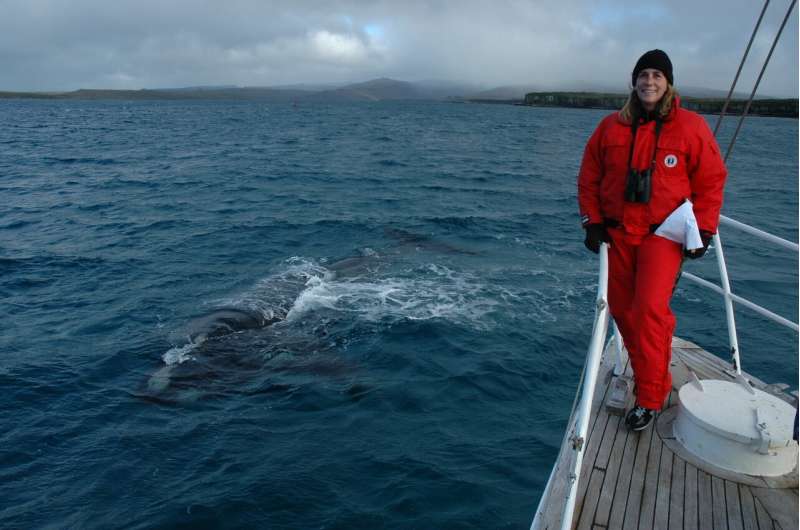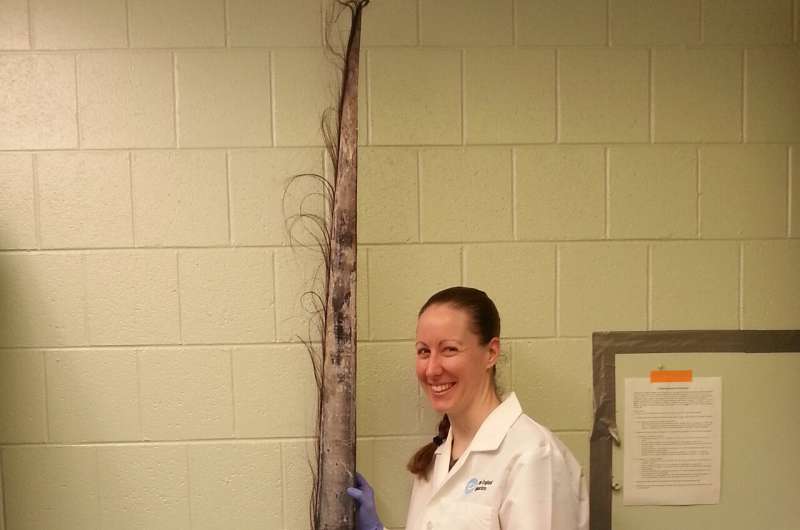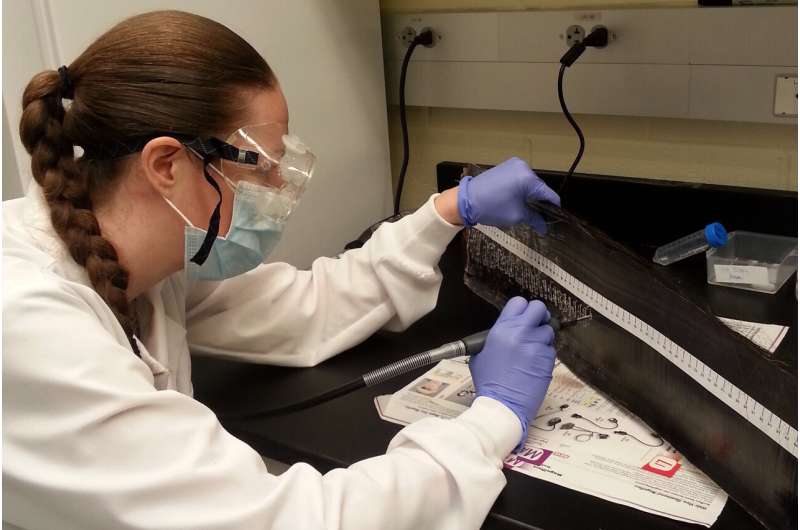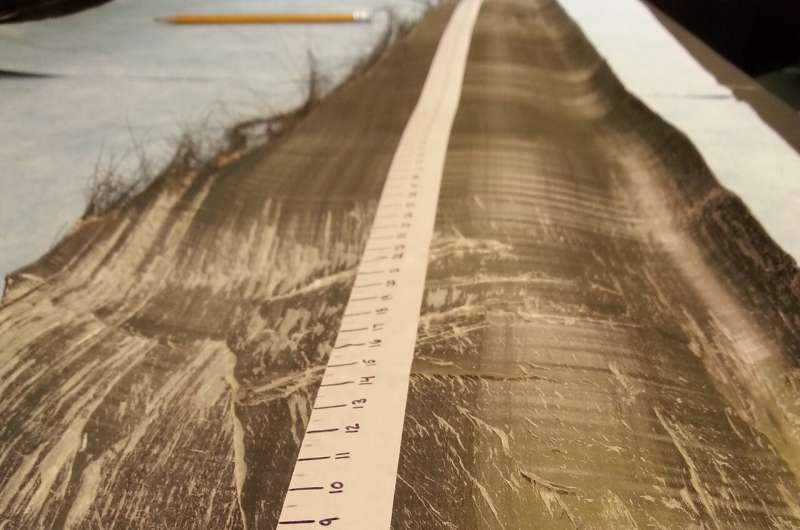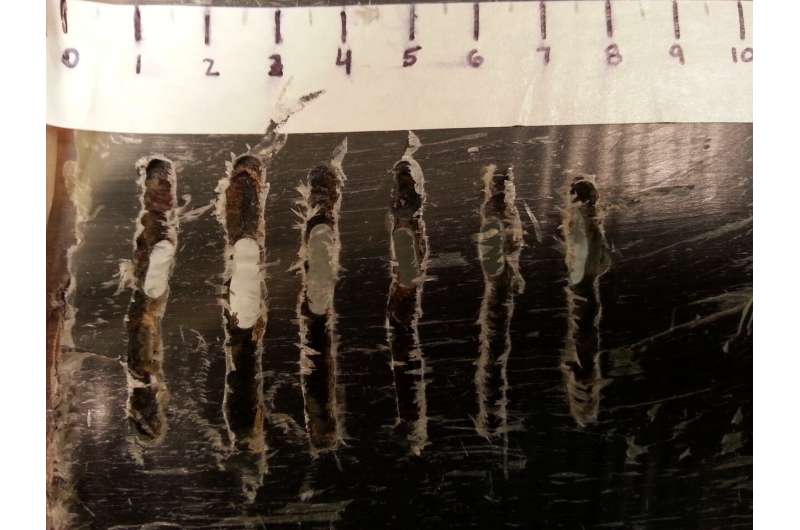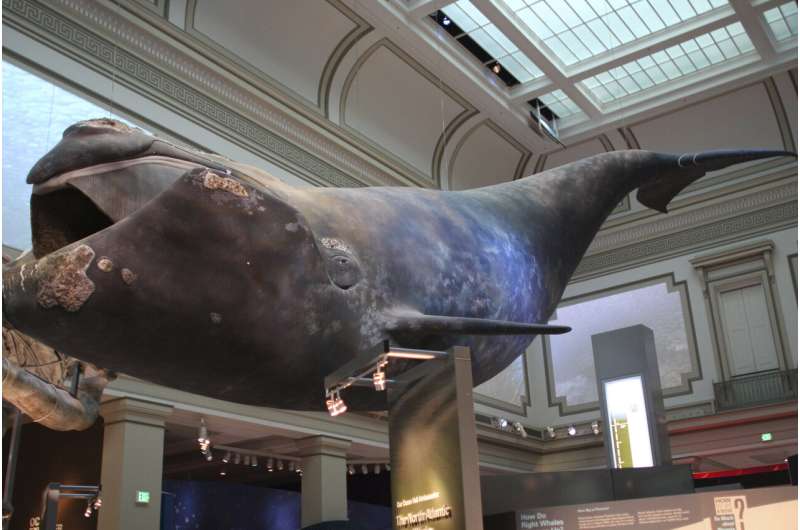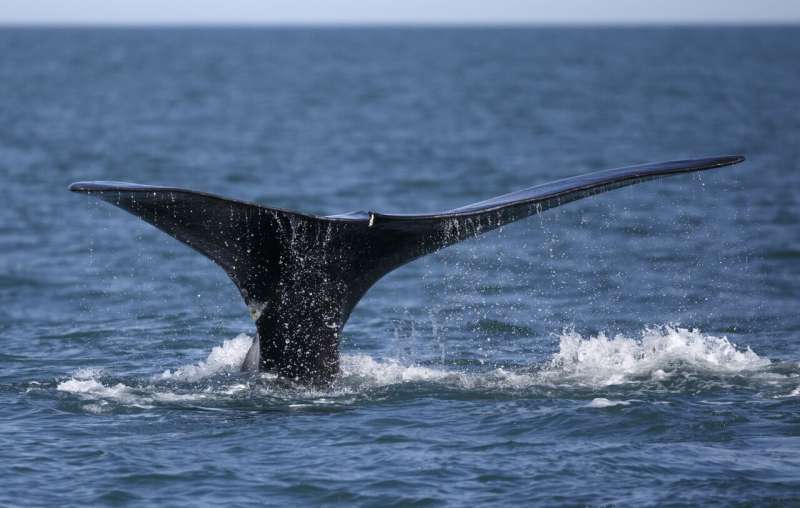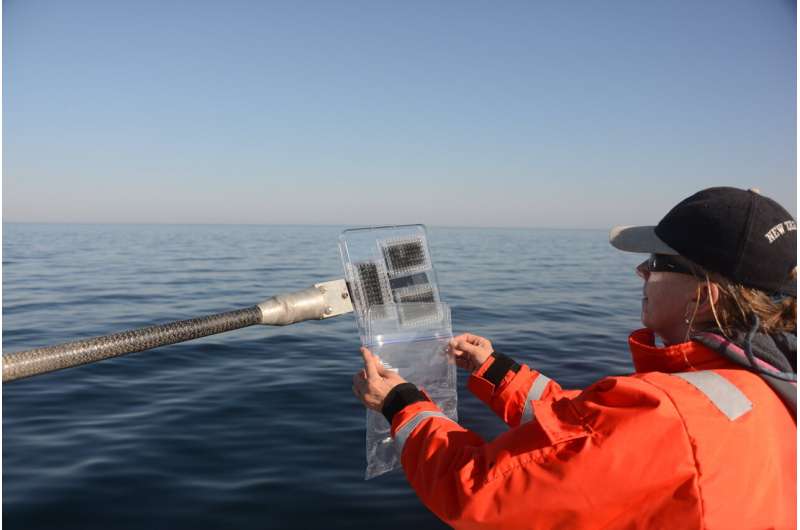In this undated photo provided by the New England Aquarium in May 2019, Dr. Rosalind Rolland, Director of Ocean Health and a Senior Scientist in the Research Department at the New England Aquarium in Boston, poses on a boat next to a southern right whale taken during an expedition to the Auckland Islands, an archipelago of New Zealand. Whale researchers in New England say they've found a new way to measure the amount of stress felt by giant whales, and the technique could help protect the massive sea creatures. (Scott Kraus/New England Aquarium via AP)
Whale researchers in New England believe they've found a new way to measure the amount of stress felt by whales when they experience traumas such as entanglements in fishing gear, and they say the technique could help protect the massive sea creatures from extinction.
The scientists, with the New England Aquarium in Boston, said the method involves measuring stress hormones by studying baleen, the bristly filter-feeding system in the mouths of the biggest whales on the planet. The baleen serves as a record that shows a spike in stress hormones when whales encounter threats such as a changing climate, ship strikes and entanglements, lead author Rosalind Rolland said.
Scientists can use the data to read the stress levels a whale experiences over the course of many years, somewhat similar to reading the rings on a tree. The data is important because whales experiencing more chronic stress are less likely to reproduce, and they can become more susceptible to disease—a bad combination for populations that are perilously low.
"A whale responding to any type of stressor could be interacting with a ship. It could be fishing gear. It could be environmental changes that stress the whale out," Rolland said in a telephone interview. "This shows the stress hormones are related to what was going on with the whale."
In this undated photo provided by the New England Aquarium in April 2019, scientist Katie Graham stands next to a sample of whale baleen in the Marine Stress Lab at the aquarium in Boston. Graham is among a group of scientists who say they've found a new way to measure the amount of stress felt by giant whales by studying the filtering structures of the giant mammals. (Anita Kim/New England Aquarium via AP)
The group published its research online in the journal Marine Mammal Science in March. The scientists reported the appearance of a whale's baleen reflects the adrenal glands pumping out stress hormones as they fight a life-threatening circumstance. By analyzing the baleen after whales die, scientists can learn about spikes in stress hormones.
The scientists performed their work on a baleen plate from a bowhead whale that had been badly entangled in fishing gear. The whale was killed off Alaska in 2017 by Inuit hunters who found it dragging fishing gear and appearing lethargic. The baleen showed a spike of stress hormones 20 times greater than normal, according to the aquarium.
The research builds on a body of work that shows stress hormones elevate when whales become entangled in fishing gear, which some scientists estimate kills up to 300,000 whales and dolphins annually.
-
In this undated photo provided by the New England Aquarium in April 2019, scientist Katie Graham conducts experiments on whale baleen in the Marine Stress Lab at the aquarium in Boston. Graham is among a group of scientists who say they've found a new way to measure the amount of stress felt by giant whales by studying the filtering structures of the giant mammals. (Anita Kim/New England Aquarium via AP)
-
In this undated photo provided by the New England Aquarium in April 2019, scientist Katie Graham conducts experiments on whale baleen in the Marine Stress Lab at the aquarium in Boston. Graham is among a group of scientists who say they've found a new way to measure the amount of stress felt by giant whales by studying the filtering structures of the giant mammals. (Anita Kim/New England Aquarium via AP)
-
In this undated photo provided by the New England Aquarium in April 2019, scientist Katie Graham conducts experiments on whale baleen in the Marine Stress Lab at the aquarium in Boston. Graham is among a group of scientists who say they've found a new way to measure the amount of stress felt by giant whales by studying the filtering structures of the giant mammals. (Anita Kim/New England Aquarium via AP)
-
This Wednesday, Sept. 24, 2008 file photo shows a North Atlantic right whale model entitled "Phoenix" is seen in the new Sant Ocean Hall in the Smithsonian National Museum of Natural History in Washington. Whale researchers in New England believe they've found a new way to measure the amount of stress felt by whales when they experience traumas such as entanglements in fishing gear, and they say the technique could help protect the massive sea creatures from extinction. The group published its research online in the journal Marine Mammal Science in March 2019. (AP Photo/Lauren Victoria Burke)
-
In this March 28, 2018, file photo, a North Atlantic right whale appears at the surface of Cape Cod bay off the coast of Plymouth, Mass. Whale researchers in New England believe they've found a new way to measure the amount of stress felt by whales when they experience traumas such as entanglements in fishing gear, and they say the technique could help protect the massive sea creatures from extinction. The group published its research online in the journal Marine Mammal Science in March 2019. (AP Photo/Michael Dwyer, File)
-
In this April 18, 2015 photo provided by the New England Aquarium, Dr. Rosalind Rolland, Director of Ocean Health and a Senior Scientist in the Research Department at the New England Aquarium in Boston, bags a sample of a right whale blow. Whale researchers in New England say they've found a new way to measure the amount of stress felt by giant whales, and the technique could help protect the massive sea creatures. (Elizabeth Burgess/New England Aquarium via AP)
The aquarium has touted the work as a "significant" breakthrough in the way whales' stress hormones can be studied. The scientists published an earlier pilot paper on the subject in 2014.
The work on whale baleen is being revealed as fishermen, conservationists and the governments struggle with how to protect marine mammal species in decline due to accidental deaths and climate change, which has made key food sources less available to some whales. The endangered North Atlantic right whale is of particular concern, because its population is so small and is steadily falling—only 411 of the whales are left, down from 480 less than a decade ago. The U.S. lobster fishing industry is bracing for new restrictions this year designed to protect the species.
The research at the New England Aquarium provides a chilling perspective on human influences on whale health as well as a new scientific tool to help save them, said Regina Asmutis-Silvia, a biologist with Whale and Dolphin Conservation in Plymouth, Massachusetts who was not involved in the study.
"This study demonstrates that chronic entanglements are not simply restricting a whale's movements, damaging their tissues or impacting their ability to feed, but are triggering a physiological response that can alter their immune systems, their ability to reproduce, and even their ability to grow," she said. "We clearly understand that stress is bad for humans, but we also need to understand that stress is not exclusive to humans."
© 2019 The Associated Press. All rights reserved.
